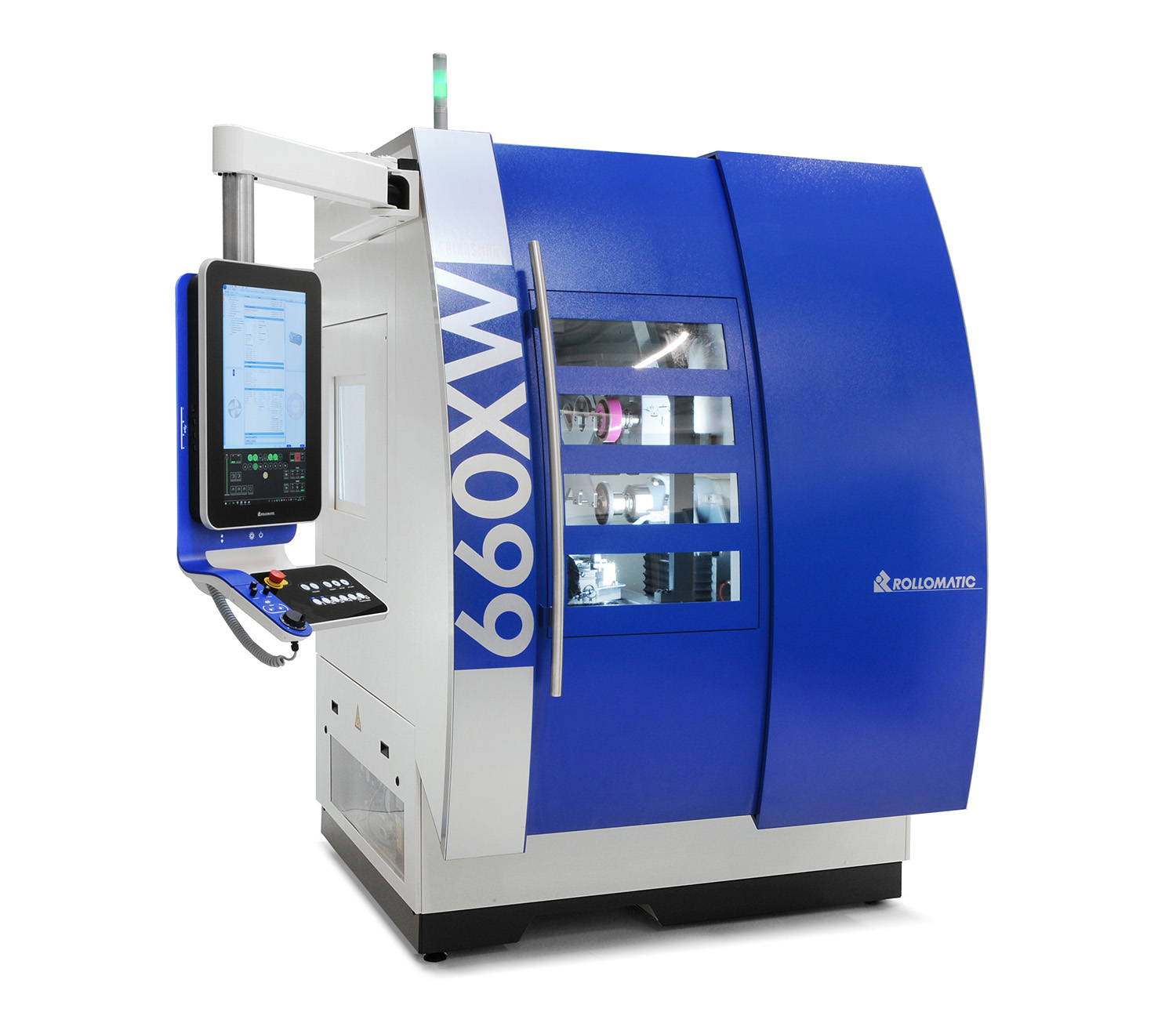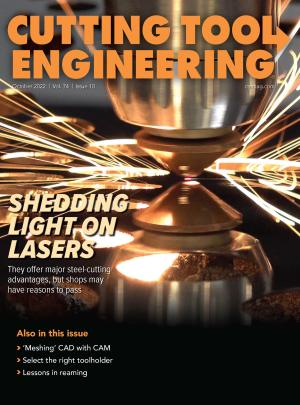There is no need for different machines for the different operations required to grind solid rotary cutting tools.
That explains why demand is healthy for the GrindSmart 660XW from Switzerland-based Rollomatic. This hybrid tool-grinding machine handles both grinding of cutting geometries and peel grinding for other tool production tasks. These include plunge-grinding operations, blank preparation for common-shank rotary cutting tools and neck grinding for long-reach mold-and-die endmills.
“To our knowledge, there is no other machine on the market with this kind of ability,” said Eric Schwarzenbach, president of Rollomatic Inc., the company’s North American headquarters in Mundelein, Illinois.
The six-axis GrindSmart 660XW allows users to employ what Rollomatic calls an ultralean process that eliminates the need for multiple machines and setups to complete all the steps necessary to grind a tool. One result is a much quicker process.

“If you do it on three different machines, it can take days or weeks to complete,” Schwarzenbach said. “But on one machine, it is done in one chucking.”
In addition, he pointed out that process management is easier when only one machine is involved, and there’s also a lower risk of tool damage due to less handling and transportation.
To combine grinding of cutting geometries and peel grinding in a single machine, the GrindSmart 660XW features a traveling high-speed workhead mounted on a CNC linear axis. The machine also includes a novel steady rest system designed to provide good support during both fluting and drill-pointing operations. Thanks to the traveling workhead, the grinding wheel is always on top of the steady rest during peel grinding, which makes for a more stable process. In addition, the grinding wheel position remains fixed and close to the steady support point to prevent problematic deflection regardless of the length of the tool.
The one-piece steady rest includes a half-round for support during fluting and a bushing for support during point grinding.
“With a half-round, the advantage is that you can grind flutes faster because you have a solid support and there’s no deflection,” Schwarzenbach said. “And the bushing will hold a drill in place so we can grind a lot faster on the point than we would if there was no support.”
The machine also comes with a 20-hp synchronous spindle motor and a six-station wheel changer that can accommodate a variety of grinding wheels for different operations.
Another key feature of the GrindSmart 660XW is a double-skin coolant enclosure. With this design, the system as a whole is standing on eight feet — four for the machine itself and four for the enclosure. Standing on its own feet, the enclosure is disconnected mechanically from the machine and not touching it. Schwarzenbach said the purpose of the separation is twofold: to provide thermal stability by shielding the machine from outside temperature fluctuations and to prevent vibrations from being transmitted to the machine through the enclosure.
Offering a grinding diameter range from microsize to 12.7 mm (0.5") and a maximum grinding length of 152.4 mm (6"), the GrindSmart 660XW is designed to produce smaller cutting tools.
“If we made the same machine for (tool diameters) up to 1" (25.4 mm), it would be much larger in size and also more expensive,” Schwarzenbach said.
Measuring 2.26 m high × 1.83 m long × 1.55 m wide (89"×72"×61"), the GrindSmart 660XW deliberately was made to be a tall machine.
“We built the machine up in height and kept the footprint small so it can save users real estate in their factories,” Schwarzenbach said.
Contact Details
Related Glossary Terms
- bushing
bushing
Cylindrical sleeve, typically made from high-grade tool steel, inserted into a jig fixture to guide cutting tools. There are three main types: renewable, used in liners that in turn are installed in the jig; press-fit, installed directly in the jig for short production runs; and liner (or master), installed permanently in a jig to receive renewable bushing.
- computer numerical control ( CNC)
computer numerical control ( CNC)
Microprocessor-based controller dedicated to a machine tool that permits the creation or modification of parts. Programmed numerical control activates the machine’s servos and spindle drives and controls the various machining operations. See DNC, direct numerical control; NC, numerical control.
- coolant
coolant
Fluid that reduces temperature buildup at the tool/workpiece interface during machining. Normally takes the form of a liquid such as soluble or chemical mixtures (semisynthetic, synthetic) but can be pressurized air or other gas. Because of water’s ability to absorb great quantities of heat, it is widely used as a coolant and vehicle for various cutting compounds, with the water-to-compound ratio varying with the machining task. See cutting fluid; semisynthetic cutting fluid; soluble-oil cutting fluid; synthetic cutting fluid.
- flutes
flutes
Grooves and spaces in the body of a tool that permit chip removal from, and cutting-fluid application to, the point of cut.
- fluting
fluting
Cutting straight or spiral grooves in drills, endmills, reamers and taps to improve cutting action and remove chips.
- grinding
grinding
Machining operation in which material is removed from the workpiece by a powered abrasive wheel, stone, belt, paste, sheet, compound, slurry, etc. Takes various forms: surface grinding (creates flat and/or squared surfaces); cylindrical grinding (for external cylindrical and tapered shapes, fillets, undercuts, etc.); centerless grinding; chamfering; thread and form grinding; tool and cutter grinding; offhand grinding; lapping and polishing (grinding with extremely fine grits to create ultrasmooth surfaces); honing; and disc grinding.
- grinding wheel
grinding wheel
Wheel formed from abrasive material mixed in a suitable matrix. Takes a variety of shapes but falls into two basic categories: one that cuts on its periphery, as in reciprocating grinding, and one that cuts on its side or face, as in tool and cutter grinding.
- steady rest
steady rest
Supports long, thin or flexible work being turned on a lathe. Mounts on the bed’s ways and, unlike a follower rest, remains at the point where mounted. See follower rest.



